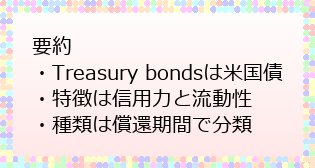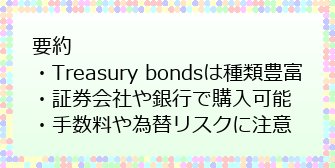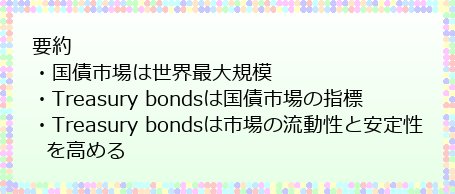| 項目 | 内容 |
|---|---|
| 定義 | アメリカ合衆国財務省が発行する国債 |
| 別名 | T-Bond |
| 特徴 | 高い信用力、高い流動性、利付債、満期まで保有すると元本が保証される |
| 種類 | Treasury bills (T-Bills), Treasury notes (T-Notes), Treasury bonds (T-Bonds), インフレ連動債 (TIPS) |
| 取引方法 | 証券会社や銀行を通じて購入、TreasuryDirectから直接購入 |
| 価格変動要因 | 金利、市場の需給、経済状況、政治情勢 |
| メリット | 安全性の高さ、流動性の高さ、利息収入、元本保証 |
| デメリット | 金利上昇リスク、インフレリスク、流動性リスク、為替リスク |
1. Treasury bondsの定義と特徴

Treasury bondsとは何か?
Treasury bondsとは、アメリカ合衆国財務省が発行する国債のことです。世界最大の経済大国であるアメリカ合衆国政府が発行する債券であるため、世界中の投資家から高い信頼を得ています。そのため、Treasury bondsは、安全性の高い投資対象として認識されています。
Treasury bondsは、政府が資金を調達するために発行する借用証書のようなものです。投資家はTreasury bondsを購入することで、アメリカ合衆国政府にお金を貸し出すことになります。そして、政府は、一定期間後に元本と利息を投資家に返済するという約束をします。
Treasury bondsは、償還期間が10年以上の長期債券です。そのため、長期的な安定収入を得たい投資家にとって魅力的な投資対象となっています。また、流動性が高く、売却しやすいという特徴もあります。
Treasury bondsは、T-Bondとも呼ばれます。これは、Treasury bondsの略称です。
| 種類 | 償還期間 | 特徴 |
|---|---|---|
| Treasury bills (T-Bills) | 1年未満 | 割引債 |
| Treasury notes (T-Notes) | 2年から10年 | 利付債 |
| Treasury bonds (T-Bonds) | 10年以上 | 利付債 |
| インフレ連動債 (TIPS) | 5, 10, 30年 | 元本とクーポンが物価指数に連動 |
Treasury bondsの特徴
Treasury bondsは、高い信用力と高い流動性を兼ね備えています。アメリカ合衆国政府の財政力によって裏付けられているため、デフォルトのリスクが非常に低いと言われています。また、世界中で取引されているため、売却しやすいという特徴があります。
Treasury bondsは、利付債です。つまり、定期的に利息が支払われます。利息の支払いは、半年ごとに行われます。
Treasury bondsは、満期まで保有すると元本が保証されます。ただし、満期前に売却した場合は、市場価格によって損失が発生する可能性があります。
Treasury bondsは、投資家のニーズに合わせて様々な種類があります。例えば、償還期間や利回りなどが異なります。
| 段階 | 内容 |
|---|---|
| 発行 | アメリカ合衆国財務省がオークションで発行 |
| 流通 | 一次市場で発行後、二次市場で取引 |
| 購入方法 | 証券会社、銀行、TreasuryDirect |
Treasury bondsの発行と流通
Treasury bondsは、アメリカ合衆国財務省が定期的にオークションを行い、発行されます。オークションでは、投資家から最も高い価格を提示した者が、Treasury bondsを購入することができます。
Treasury bondsは、一次市場で発行された後、二次市場で取引されます。二次市場では、投資家同士がTreasury bondsを売買します。
Treasury bondsは、証券会社や銀行を通じて購入することができます。また、アメリカ合衆国財務省が運営するTreasuryDirectというウェブサイトからも直接購入することができます。
Treasury bondsは、世界中の投資家から人気のある投資対象です。そのため、市場規模が大きく、流動性が高いという特徴があります。
まとめ
Treasury bondsは、アメリカ合衆国政府が発行する国債であり、高い信用力と流動性を備えています。長期的な安定収入を得たい投資家にとって魅力的な投資対象です。
Treasury bondsは、T-Bondとも呼ばれ、定期的に利息が支払われ、満期まで保有すると元本が保証されます。
Treasury bondsは、オークションで発行され、二次市場で取引されます。証券会社や銀行を通じて購入することができます。
Treasury bondsは、世界中の投資家から人気のある投資対象であり、市場規模が大きく、流動性が高いという特徴があります。
2. Treasury bondsのリスクとリターン

Treasury bondsのリスク
Treasury bondsは、世界中の投資家から高い信頼を得ているため、デフォルトのリスクが非常に低いと言われています。しかし、リスクが全くないわけではありません。
Treasury bondsの最大のリスクは、金利上昇リスクです。金利が上昇すると、Treasury bondsの価格が下落します。これは、金利が上昇すると、新規発行される債券の利回りが高くなるため、既存の債券の価値が相対的に下がるからです。
Treasury bondsは、インフレリスクも抱えています。インフレが進むと、債券の価値が実質的に目減りしてしまいます。これは、インフレが進むと、物価が上昇し、債券から得られる利息の価値が低下するためです。
Treasury bondsは、流動性リスクも存在します。これは、売却したいときに、希望する価格で売却できない可能性があるリスクです。特に、市場が不安定な時期には、流動性リスクが高まります。
| リスク | 内容 |
|---|---|
| 金利上昇リスク | 金利上昇で価格下落 |
| インフレリスク | インフレで価値目減り |
| 流動性リスク | 売却時に希望価格で売れない可能性 |
| 為替リスク | 円高で損失発生の可能性 |
Treasury bondsのリターン
Treasury bondsは、安全性の高い投資対象であるため、リターンは株式投資などと比べて低めです。しかし、安定した収入を得たい投資家にとっては、魅力的な投資対象となります。
Treasury bondsのリターンは、利息収入と価格変動によって決まります。利息収入は、債券のクーポンレートによって決まります。価格変動は、金利の動きや市場の需給によって決まります。
Treasury bondsは、満期まで保有すると元本が保証されます。そのため、元本を確実に守りたい投資家にとって、安心できる投資対象となります。
Treasury bondsは、長期投資に向いている投資対象です。短期的な値上がりを期待するのではなく、長期的に安定した収入を得ることを目的とした投資に適しています。
| リターン | 内容 |
|---|---|
| 利息収入 | 債券のクーポンレートによる |
| 価格変動 | 金利の動きや市場の需給による |
| 元本保証 | 満期まで保有すると元本が保証される |
Treasury bondsのリスクとリターンの関係
Treasury bondsは、リスクとリターンが比例するという原則に従っています。リスクが高い債券ほど、リターンも高くなる傾向があります。
Treasury bondsは、安全性の高い債券であるため、リターンは低めです。しかし、リスクが低いというメリットがあります。
Treasury bondsは、投資家のリスク許容度によって、適切な債券を選ぶことが重要です。リスク許容度が低い投資家は、安全性の高い債券を選ぶべきです。リスク許容度が高い投資家は、リターンが高い債券を選ぶことができます。
Treasury bondsは、投資家の投資目的によって、適切な債券を選ぶことが重要です。短期的な利益を期待する投資家には、流動性の高い債券が適しています。長期的な安定収入を期待する投資家には、償還期間の長い債券が適しています。
まとめ
Treasury bondsは、安全性の高い投資対象ですが、金利上昇リスク、インフレリスク、流動性リスクなどのリスクも存在します。
Treasury bondsのリターンは、利息収入と価格変動によって決まります。リスクとリターンは比例するため、リスク許容度や投資目的に合わせて適切な債券を選ぶことが重要です。
Treasury bondsは、長期投資に向いている投資対象です。短期的な値上がりを期待するのではなく、長期的に安定した収入を得ることを目的とした投資に適しています。
Treasury bondsは、投資家のリスク許容度や投資目的に合わせて、適切な債券を選ぶことが重要です。
3. Treasury bondsの種類と取引方法

Treasury bondsの種類
Treasury bondsは、償還期間や利回りによって、様々な種類に分類されます。
Treasury bills (T-Bills)は、償還期間が1年未満の短期国債です。割引債として発行され、満期時に額面価格で償還されます。
Treasury notes (T-Notes)は、償還期間が2年から10年の中期国債です。利付債として発行され、定期的に利息が支払われます。
Treasury bonds (T-Bonds)は、償還期間が10年以上の長期国債です。利付債として発行され、定期的に利息が支払われます。
| 種類 | 償還期間 | 特徴 |
|---|---|---|
| Treasury bills (T-Bills) | 1年未満 | 割引債 |
| Treasury notes (T-Notes) | 2年から10年 | 利付債 |
| Treasury bonds (T-Bonds) | 10年以上 | 利付債 |
| インフレ連動債 (TIPS) | 5, 10, 30年 | 元本とクーポンが物価指数に連動 |
Treasury bondsの取引方法
Treasury bondsは、証券会社や銀行を通じて購入することができます。また、アメリカ合衆国財務省が運営するTreasuryDirectというウェブサイトからも直接購入することができます。
Treasury bondsは、一次市場と二次市場で取引されます。一次市場では、アメリカ合衆国財務省が発行するTreasury bondsを直接購入することができます。二次市場では、投資家同士がTreasury bondsを売買します。
Treasury bondsの取引には、手数料がかかります。手数料は、証券会社や銀行によって異なります。
Treasury bondsの取引には、為替リスクも伴います。これは、Treasury bondsが米ドル建てで発行されているため、円高になると、損失が発生する可能性があるからです。
| 取引方法 | 内容 |
|---|---|
| 証券会社・銀行 | 購入、売却 |
| TreasuryDirect | 直接購入 |
| 一次市場 | アメリカ合衆国財務省から直接購入 |
| 二次市場 | 投資家同士で売買 |
Treasury bondsの取引方法
Treasury bondsは、証券会社や銀行を通じて購入することができます。また、アメリカ合衆国財務省が運営するTreasuryDirectというウェブサイトからも直接購入することができます。
Treasury bondsは、一次市場と二次市場で取引されます。一次市場では、アメリカ合衆国財務省が発行するTreasury bondsを直接購入することができます。二次市場では、投資家同士がTreasury bondsを売買します。
Treasury bondsの取引には、手数料がかかります。手数料は、証券会社や銀行によって異なります。
Treasury bondsの取引には、為替リスクも伴います。これは、Treasury bondsが米ドル建てで発行されているため、円高になると、損失が発生する可能性があるからです。
まとめ
Treasury bondsは、償還期間や利回りによって、様々な種類に分類されます。
Treasury bondsは、証券会社や銀行を通じて購入することができます。また、アメリカ合衆国財務省が運営するTreasuryDirectというウェブサイトからも直接購入することができます。
Treasury bondsの取引には、手数料や為替リスクが伴います。
Treasury bondsの取引方法を理解した上で、投資を行うことが重要です。
4. Treasury bondsの価格変動と影響要因

Treasury bondsの価格変動
Treasury bondsの価格は、金利や市場の需給によって変動します。
金利が上昇すると、Treasury bondsの価格は下落します。これは、金利が上昇すると、新規発行される債券の利回りが高くなるため、既存の債券の価値が相対的に下がるからです。
市場の需給も、Treasury bondsの価格に影響を与えます。Treasury bondsの需要が高まると、価格は上昇します。Treasury bondsの供給が増えると、価格は下落します。
Treasury bondsの価格は、経済状況や政治情勢などの要因によっても影響を受けます。
| 要因 | 影響 |
|---|---|
| 金利上昇 | 価格下落 |
| 市場の需給増加 | 価格上昇 |
| 経済状況悪化 | 価格下落 |
| 政治情勢不安定 | 価格下落 |
Treasury bondsの価格変動に影響を与える要因
Treasury bondsの価格変動に影響を与える要因は、金利、インフレ、経済成長、政治情勢など、様々なものがあります。
金利は、Treasury bondsの価格に最も大きな影響を与える要因の一つです。金利が上昇すると、Treasury bondsの価格は下落します。これは、金利が上昇すると、新規発行される債券の利回りが高くなるため、既存の債券の価値が相対的に下がるからです。
インフレも、Treasury bondsの価格に影響を与えます。インフレが進むと、Treasury bondsの価値が実質的に目減りしてしまいます。これは、インフレが進むと、物価が上昇し、債券から得られる利息の価値が低下するためです。
経済成長も、Treasury bondsの価格に影響を与えます。経済成長が鈍化すると、Treasury bondsの需要が減少し、価格は下落する可能性があります。
Treasury bondsの価格変動予測
Treasury bondsの価格変動を予測することは、非常に難しいことです。しかし、金利、インフレ、経済成長、政治情勢などの要因を分析することで、ある程度の予測をすることは可能です。
金利は、中央銀行の金融政策によって大きく影響されます。中央銀行が利下げを行うと、金利が低下し、Treasury bondsの価格は上昇する傾向があります。中央銀行が利上げを行うと、金利が上昇し、Treasury bondsの価格は下落する傾向があります。
インフレは、物価上昇率によって測定されます。インフレが進むと、Treasury bondsの価値が実質的に目減りしてしまいます。そのため、インフレが進むと、Treasury bondsの価格は下落する傾向があります。
経済成長は、GDPの成長率によって測定されます。経済成長が鈍化すると、Treasury bondsの需要が減少し、価格は下落する可能性があります。
まとめ
Treasury bondsの価格は、金利、市場の需給、経済状況、政治情勢などの様々な要因によって変動します。
金利が上昇すると、Treasury bondsの価格は下落します。インフレが進むと、Treasury bondsの価値が実質的に目減りしてしまいます。経済成長が鈍化すると、Treasury bondsの需要が減少する可能性があります。
Treasury bondsの価格変動を予測することは難しいですが、金利、インフレ、経済成長、政治情勢などの要因を分析することで、ある程度の予測をすることは可能です。
Treasury bondsの価格変動を理解した上で、投資を行うことが重要です。
5. Treasury bondsと国債市場の関係

国債市場とは
国債市場とは、国が発行する国債が取引される市場のことです。国債市場は、世界で最も規模が大きい金融市場の一つです。
国債市場では、国債の発行、売買、償還などが行われます。国債市場は、経済活動や金融政策に大きな影響を与えています。
国債市場は、一次市場と二次市場に分けられます。一次市場では、国が国債を新規発行します。二次市場では、投資家同士が国債を売買します。
国債市場は、世界中の投資家が参加するグローバルな市場です。そのため、国債の価格や利回りは、世界経済や金融政策などの要因によって影響を受けます。
| 分類 | 内容 |
|---|---|
| 一次市場 | 国が国債を新規発行 |
| 二次市場 | 投資家同士が国債を売買 |
Treasury bondsと国債市場の関係
Treasury bondsは、アメリカ合衆国政府が発行する国債であり、世界中の国債市場で取引されています。
Treasury bondsは、国債市場の指標とされています。Treasury bondsの利回りは、世界中の国債の利回りに影響を与えます。
Treasury bondsは、国債市場の流動性を高める役割を果たしています。Treasury bondsは、世界中で取引されているため、売買しやすいという特徴があります。
Treasury bondsは、国債市場の安定性にも貢献しています。Treasury bondsは、安全性の高い投資対象とされているため、投資家の信頼を得ています。
Treasury bondsと国債市場の動向
Treasury bondsの価格変動は、国債市場の動向を反映しています。金利が上昇すると、Treasury bondsの価格が下落し、国債市場全体も下落する傾向があります。
経済成長が鈍化すると、Treasury bondsの需要が減少し、価格は下落する可能性があります。これは、国債市場全体にも影響を与えます。
政治情勢も、Treasury bondsの価格変動に影響を与えます。政治不安定な状況では、Treasury bondsの需要が減少し、価格は下落する可能性があります。
Treasury bondsは、国債市場の動向を把握する上で、重要な指標となります。
まとめ
Treasury bondsは、世界中の国債市場で取引されています。
Treasury bondsは、国債市場の指標とされており、その利回りは世界中の国債の利回りに影響を与えます。
Treasury bondsは、国債市場の流動性と安定性を高める役割を果たしています。
Treasury bondsの価格変動は、国債市場の動向を反映しています。
6. Treasury bondsのメリットとデメリット

Treasury bondsのメリット
Treasury bondsは、安全性の高い投資対象です。アメリカ合衆国政府の財政力によって裏付けられているため、デフォルトのリスクが非常に低いと言われています。
Treasury bondsは、流動性が高いです。世界中で取引されているため、売却しやすいという特徴があります。
Treasury bondsは、利付債です。つまり、定期的に利息が支払われます。利息の支払いは、半年ごとに行われます。
Treasury bondsは、満期まで保有すると元本が保証されます。そのため、元本を確実に守りたい投資家にとって、安心できる投資対象となります。
| メリット | 内容 |
|---|---|
| 安全性 | アメリカ合衆国政府の財政力による裏付け |
| 流動性 | 世界中で取引されているため売却しやすい |
| 利息収入 | 定期的に利息が支払われる |
| 元本保証 | 満期まで保有すると元本が保証される |
Treasury bondsのデメリット
Treasury bondsは、金利上昇リスクがあります。金利が上昇すると、Treasury bondsの価格が下落します。
Treasury bondsは、インフレリスクがあります。インフレが進むと、債券の価値が実質的に目減りしてしまいます。
Treasury bondsは、流動性リスクも存在します。これは、売却したいときに、希望する価格で売却できない可能性があるリスクです。
Treasury bondsは、為替リスクも伴います。これは、Treasury bondsが米ドル建てで発行されているため、円高になると、損失が発生する可能性があるからです。
| デメリット | 内容 |
|---|---|
| 金利上昇リスク | 金利上昇で価格下落 |
| インフレリスク | インフレで価値目減り |
| 流動性リスク | 売却時に希望価格で売れない可能性 |
| 為替リスク | 円高で損失発生の可能性 |
Treasury bondsのメリットとデメリットのまとめ
Treasury bondsは、安全性の高い投資対象ですが、金利上昇リスク、インフレリスク、流動性リスク、為替リスクなどのデメリットも存在します。
Treasury bondsは、長期投資に向いている投資対象です。短期的な値上がりを期待するのではなく、長期的に安定した収入を得ることを目的とした投資に適しています。
Treasury bondsは、投資家のリスク許容度や投資目的によって、適切な債券を選ぶことが重要です。
Treasury bondsは、投資家のニーズに合わせて様々な種類があります。例えば、償還期間や利回りなどが異なります。
まとめ
Treasury bondsは、安全性の高い投資対象ですが、金利上昇リスク、インフレリスク、流動性リスク、為替リスクなどのデメリットも存在します。
Treasury bondsは、長期投資に向いている投資対象です。短期的な値上がりを期待するのではなく、長期的に安定した収入を得ることを目的とした投資に適しています。
Treasury bondsは、投資家のリスク許容度や投資目的に合わせて、適切な債券を選ぶことが重要です。
Treasury bondsは、投資家のニーズに合わせて様々な種類があります。例えば、償還期間や利回りなどが異なります。
参考文献
・Treasury bonds | 金融・証券用語解説集 | 大和証券
・トレジャリーボンドとは|債券投資の基礎知識|iFinance
・わかりやすい用語集 解説:Treasury bonds(とれじゃりーぼんど) | 三井住友DSアセットマネジメント
・Treasury bondsとは?株式用語解説 – お客様サポート – DMM 株
・トレジャリー・米国債(米国財務省証券)とは|Fx 用語辞典| 東西fx
・Treasury Bonds — TreasuryDirect
・すべては「トレジャリー」から 米金利を知ろう 相場のキホン・米国編(6) – 日本経済新聞
・世界の債券が値上がり、金利はピークに近づいているとの見方 – Bloomberg
・トレジャリーボンド – T-Bonds:FX用語集 | フィリップ証券の外国為替証拠金(FX・スワップ)取引はフィリップFX
・国債(government bonds)とは – 知るぽると
・債券投資とは?基本知識&メリット・デメリットを専門家が解説! | マネタス【manetasu】

